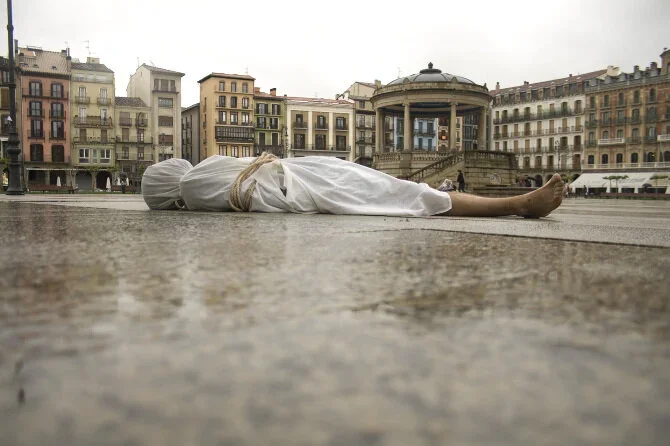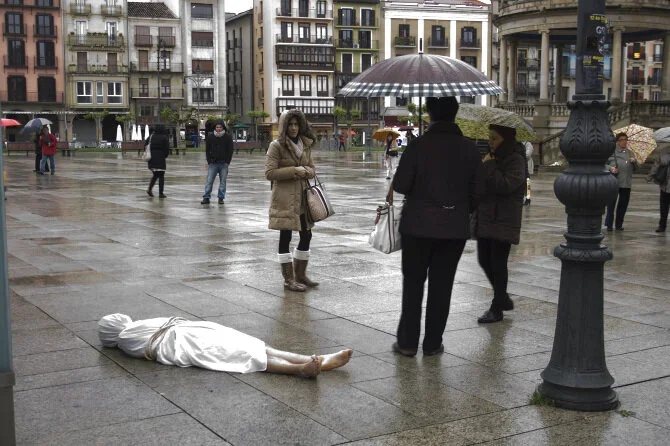“Disciplinary power is a discrete power, distributed; it is a power that works in a network and whose visibility only lies in the docility and submission of those over whom it is exercised in silence […] Disciplinary power refers to a terminal or optimal state. Look to the future, to the moment when everything works by itself and vigilance has only a virtual character, when discipline has therefore become a habit.”
“El poder disciplinario es un poder discreto, repartido; es un poder que funciona en red y cuya visibilidad sólo radica en la docilidad y sumisión de aquellos sobre quienes se ejerce en silencio […] El poder disciplinario se refiere a un estado terminal u óptimo. Mira hacia el porvenir, hacia el momento en que todo funcione por sí solo y la vigilancia no tenga más que un carácter virtual, cuando la disciplina, por consiguiente, se haya convertido en un hábito.”
This piece was curated by Colombian Commissioner Carlos Arturo Del Toro, a graduate in Art History and Philosophy and an expert in contemporary research. Photography: Celeste Pelegrini. / Esta pieza fue comisariada por el comisario colombiano Carlos Arturo Del Toro, licenciado en Historia del Arte y Filosofía y experto en investigación contemporánea. Fotografía: Celeste Pelegrini.
The Silence is a work designed, developed and performatized by Abel Azcona in June 2012 in Pamplona, the artist's adoptive city. It has it's bass in his childhood, marked by abandonment and an adoption impregnated by the palpable conservatism of one of the most catholics cities in northern Spain.
The artist Abel Azcona naked, covered by a white sheet and gagged with a rope, remained for three hours in the Plaza del Castillo in his hometown, Pamplona. Without any movement, totally inert as a corpse, he is confused by the viewer. A forced silence in the heart of Pamplona. A performance art piece marked by rain, the spectator's concern and the constant police presence. This living installation was exposed in its entirety to the public, to its evaluation and to its participation in it. The performance Silence is a silent cry of protest, it is a call against the systematic alienation to which we are exposed, it is a form of fight to combat the thousands of invisible chains that keep us in a state of mental slavery.
Abel Azcona, for three hours lied naked in the Plaza del Castillo in Pamplona. Wrapped in a white sheet, and tied with a rope, the artist seeks to denounce everything that is wrong in this conservative city. It denounces the hypocrisy of its thousands of inhabitants, who paradoxically profess and exalt a religion of love and at the same time stigmatize and segregate all those who do not meet the traditional parameters of normal. The interest of the performance consists in making evident what is there, in the sight of anyone who carefully analyzes it, but which all refuse to see; it consists in showing how we are silenced by social and institutional surveillance mechanisms and how we are being disciplined by a political and economic system that forces us to be immobile, naked and makes us feel fragile.
Silence tries to make evident how the Catholic religious precepts bind us and dehumanize us with their false intentions of purity and goodness; and how anyone who dares to question these ways of conceiving the world will be immediately silenced by assigning the linguistic label of abnormal or crazy.
The time passes in the Plaza del Castillo in Pamplona and the performance has fulfilled its objective. Baffled, passersby begin to emerge from their state of automation to experience surprise, amazement, outrage, and annoyance - all those emotions that break the daily grind and undoubtedly lead to cognitive change. Many of those who walk the square will believe that it is an extravagant work of art, others, an act of rebellion, the most conservative will say that it was an attack on the city and its good customs. However, it does not matter what each one thinks, since the objective has already been reached, and each one who lived with the work was forced to leave their comfort and question themselves. That is finally the goal of Abel's silence, to slap us to react to everything that is going on around us, and through shock to get us out of that state of lethargy that we have been in for a long time.
Those who are too attached to their traditional ways of understanding reality will experience only a slight tingling and a little discomfort; However, many of those who are not yet fully trained by the tyranny of this spe(cta)cular reality, will find in the work of Abel Azcona a small epiphany, a small push that will launch them into the void, so that being there, Where nothing makes sense, everyone has the possibility to start re-creating their reality
El Silencio es un obra diseñada, desarrollada y performatizada por Abel Azcona en el mes de junio de 2012 en Pamplona, ciudad adoptiva del artista.. Desde su infancia marcado por el abandono y una adopción impregnada por el conservadurismo palpable de una de las ciudades más católicas del norte de España.
El artista Abel Azcona desnudo, cubierto por una sábana blanca y amordazado con una soga permaneció durante tres horas en la Plaza del Castillo de su ciudad natal, Pamplona. Sin ningún movimiento, totalmente inerte como un cadáver, es confundido por el espectador. Un silencio forzado en el corazón de Pamplona. Un performance art marcado por la lluvia, la preocupación del espectador y la constante presencia policial. Este instalación viva fue expuesta en su totalidad al público, a su valoración y a su participación en la misma. El performance Silence es un grito mudo de protesta, es un llamado en contra de la alienación sistemática a la que nos tienen expuestos, es una forma de lucha para combatir las miles de cadenas invisibles que nos mantienen en un estado de esclavitud mental.
Abel Azcona, durante tres horas se tiende desnudo en la Plaza del Castillo de Pamplona. Envuelto en una sábana blanca, y maniatado con una soga, el artista busca denunciar todo lo que está mal en esta conservadora ciudad. Denuncia la hipocresía de sus miles de habitantes, quienes paradójicamente profesan y exaltan una religión de amor y al mismo tiempo estigmatizan y segregan a todos aquellos que no cumplen con los parámetros tradicionales de normal. El interés de la performance consiste en hacer evidente lo que está ahí, a la vista de cualquiera que lo analice con cuidado, pero que todos se niegan a ver; consiste en mostrar cómo nos encontramos enmudecidos por los mecanismos de vigilancia sociales e institucionales y cómo estamos siendo disciplinados por un sistema político y económico que nos obliga a estar inmóviles, desnudos y nos hace sentir frágiles.
Silence trata de hacer evidente cómo los preceptos religiosos católicos nos amarran y nos deshumanizan con sus falsas intenciones de pureza y de bondad; y cómo todo aquel que se atreva a cuestionar estas formas de concebir el mundo será inmediatamente silenciado asignándole el rótulo lingüístico de anormal o loco.
El tiempo transcurre en la Plaza del Castillo de Pamplona y el performance ha cumplido su objetivo. Desconcertados, los transeúntes comienzan a salir de su estado de automatización para experimentar la sorpresa, el asombro, la indignación y la molestia: todas esas emociones que rompen con la rutina cotidiana y nos llevan indudablemente a un cambio cognitivo. Muchos de los que recorren la plaza van a creer que se trata de una extravagante obra de arte, otros, de un acto de rebeldía, los más conservadores dirán que aquello fue un atentado contra la ciudad y sus buenas costumbres. Sin embargo, poco importa lo que cada uno piense, pues el objetivo ya fue alcanzado, y cada uno de los que convivió con la obra se vio obligado a salir de su comodidad y a cuestionarse. Ése es finalmente el objetivo del silencio de Abel, darnos una bofetada para que reaccionemos ante todo lo que está pasando a nuestro alrededor, y por medio de un shock sacarnos de ese estado de letargo en el que hemos estado durante mucho tiempo. Aquellos que se encuentran demasiado apegados a sus formas tradicionales de entender la realidad, experimentarán sólo un leve cosquilleo y una pequeña molestia; sin embargo, muchos de los que aún no se hallan completamente adiestrados por la tiranía de esta realidad espe(cta)cular, encontrarán en la obra de Abel Azcona una pequeña epifanía, un pequeño empujón que los lanzará al vacío, para que estando allí, en donde nada tiene sentido, cada uno tenga la posibilidad de comenzar a re-crear su realidad.












